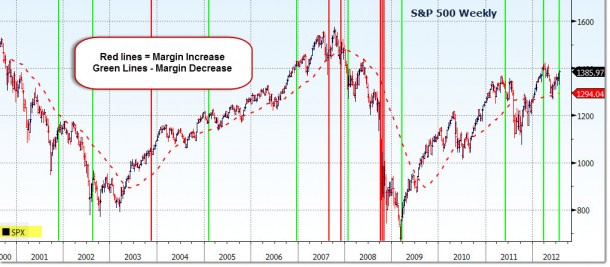 There has been some talk/blogging that the recent changes in the CME margin requirements were partly to “blame” for last week’s enormous rally in stocks. On Thursday, the CME announced that they would be lowering margin requirements for futures on most S&P 500 sectors. We wondered if changes to the initial and maintenance requirements can be directly linked to subsequent moves in the S&P 500 index as some suggest.
There has been some talk/blogging that the recent changes in the CME margin requirements were partly to “blame” for last week’s enormous rally in stocks. On Thursday, the CME announced that they would be lowering margin requirements for futures on most S&P 500 sectors. We wondered if changes to the initial and maintenance requirements can be directly linked to subsequent moves in the S&P 500 index as some suggest.
By lowering or raising the requirements, it is reasonable to infer that investors will have the ability to add to positions as the mandate decreases and vice-versa. So, what has been the history when charting it back in time?
Before we get to that, I found it interesting that getting the information is not so easy. I had to contact the CME several times in order to finally get someone who had to walk me through their site to find the data. In fact,the history it is nowhere to be found unless you know the actual web URL.
Below is a chart that marks the increase/decrease in margin requirements against the S&P 500 since 2001.
(It is wide, click to enlarge)
What we observed is that when margin requirements are increased, there is a tendency for markets to move lower. However, it is would be rather difficult to conclude that the any single increase is the cause of the move. Several changes in the same direction could be seen as adding fuel to the fire when a trend is gaining momentum. a good example of this is the series of increases in 2008 and how markets continued to sell off as several hikes were made during a concentrated period of time.
The CME uses margin requirements as a risk management tool. From their website:
At CME Group, we‘re intently focused on risk management. As part of our overall risk management program, margins are adjusted frequently across all of our products based on market volatility. When daily price moves become more volatile, we typically raise margins to account for the increased risk. Likewise, when daily price moves become less volatile, margins typically go down because the risk of the position also decreases.
Margins are set as part of the neutral risk management services we provide. They aren‘t a means to move a market one way or another, or to encourage or discourage participation from one kind of market participant or another. Rather, margin is one of many risk management tools that help us assess overall portfolio risk to protect market participants and the market as a whole.
So, while some may believe that there is a conspiracy to move stocks (or commodities) in one direction or another, it is not proven out as can be seen from the chart. Sure, there may be an immediate response to a change as traders adjust their positions, but that could be a temporary situation.
When focusing on the data, the only potential correlation is when margins are increased in successive steps during a short time period. Even so, there can be other explanations that are just as viable. Conspiracy? I don’t think so.
Any thoughts?
History of S&P 500 future margin requirements:
[gview file=”http://www.thedisciplinedinvestor.com/blog/wp-content/uploads/2012/07/SP_2008_to_October_2011.pdf”]

















